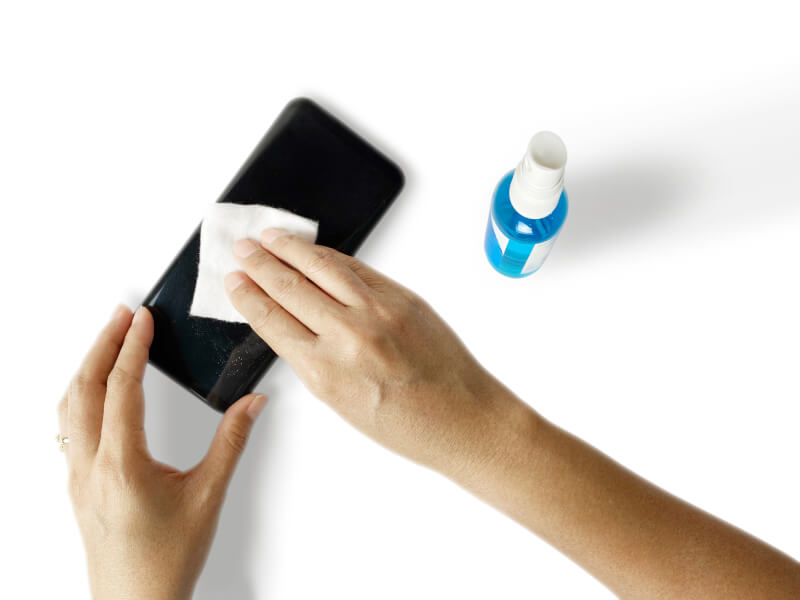
What’s the one item that never leaves your side?
It goes into the bathroom with you. You use it in the kitchen. It often touches your face, your desk and, well, just about any other surface within arm’s reach.
It’s your smartphone, of course. And the tasks listed above are just some of the reasons it’s a breeding ground for germs and a cesspool of bacteria.
As the coronavirus outbreak continues to spread throughout the world, claiming more than 3,100 deaths, keeping your hands and smartphone clean is critical.
Don’t just take our word for it.
Fecal matter can be found on 1 out of every 6 smartphones, according to a 2011 study done by researchers at the London School of Hygiene & Tropical Medicine.
“Mobile phones have become veritable reservoirs of pathogens as they touch faces, ears, lips and hands of different users of different health conditions,” researchers observed in a 2009 study of bacteria removed from personal calling devices.
A study by the University of Arizona found the typical worker’s desk, which tends to be your smartphone’s home for about 40 hours a week, has hundreds of times more bacteria per square inch than an office toilet seat.
Other studies have found serious pathogens on smartphones such as Streptococcus, MRSA – which is a type of bacteria that is resistant to several antibiotics – and even E. coli.
‘Mobile germ devices’
So, why exactly is your phone so nasty?
“We touch more surfaces than any generation in history, from ATM machines to self-checkout counters,” said Dr. Charles Gerba, a professor of microbiology at University of Arizona. “So, you’re picking up germs all the time on your hands and fingers, putting them on your cellphone and bringing them close to your nose, mouth or eyes.”
These germs can make you, your family and anyone else you come in contact with sick. In fact, the Centers for Disease Control and Prevention estimates 80 percent of all infections are transmitted by hands, and our smartphones have basically become an extension of that.
“Mobile phones are now mobile germ devices,” Gerba said. “You get a germ on your hand, and you use your phone. Then you go wash your hands later, but the germs are still on your phone.”
On average, Americans check their phone once every 12 minutes – burying their heads in their phones 80 times a day, according to global tech protection company Asurion. That’s plenty of opportunities for microorganisms to migrate between your fingers and your phone.
The worst culprits are teenagers, according to Gerba, whose research found that people who work in the food service industry along with adults who work with children tend to get the most contamination on their hands.
Think about all the surfaces you touch throughout the day, from subway poles and light switches to remote controls to bathroom doors. All of the bacteria picked up during your day-to-day activities ends up on your daily dialing devices, and odds are, you don’t clean them often or well enough.
“All cellphones are going to have bacteria on them because we hold them up to our face,” says Susan Whittier, director of clinical microbiology at New York-Presbyterian and Columbia University Medical Center.
“Normal bacteria that’s being transferred from cheeks and ears isn’t anything to worry about. But, if you’re coughing into your phone, those viruses can live on those surfaces for hours and can be transferred to others.”
What’s the solution?
Apple advises against using liquids or disinfectants on its devices. Instead, the iPhone maker offers a detailed list of how to clean your phone depending on the model that you have. Motorola suggests using a microfiber cloth — the kind you might clean your glasses with — with a little water.
As for Google’s Pixel phone, the company has given the OK to use household soap if necessary.
There are other ways you can safely clean your device depending on the type of phone you have. You may need the following materials:
- Microfiber cloth
- Isopropyl rubbing alcohol
- Water
- Cotton swabs
- Cleaning gloves
Waterproof & Water Resistant
Waterproof phones have become a big deal recently, with manufacturers keen to talk up their phone’s ability to survive a dunking. If you have one of these devices, here’s how you can clean it:
You can make your own cleaning solution with rubbing alcohol and distilled water inside a spray bottle, said Gerba, the microbiology professor. Rubbing alcohol sanitizes and evaporates quickly.
Spray the outside of the device and wipe it down using a cotton swab.
Wear gloves or wash your hands before cleaning it.
Non-Waterproof
You’ll have to be slightly more careful when wiping down a phone that isn’t water-resistant.
Lysol advertises that the wipes are “safe to use on electronics including smartphones, tablets and remote controls.” So you can carefully use one of these to wipe off the screen and back of your phone.
All smartphones
If you’re worried about using disinfectant, consider an option like “PhoneSoap,” a device that first gained attention on the ABC show Shark Tank.
It uses UV light to kill 99.9 percent of the germs on your smartphone, according to its manufacturer. It costs about $60 and can be grabbed from Amazon. A quick 10-minute stint inside the PhoneSoap not only cleans your phone but charges it, too.
Or, you can just use a standard microfiber cloth, like the one included with some smartphones.
Gerba said that it’s probably best to sanitize your phone daily. He cleans his twice a day.











